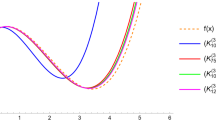Abstract
For a semigroup \(\mathcal {S}\) of Markov operators on a space of continuous functions, we use \(\mathcal {S}\)-invariant ideals to describe qualitative properties of \(\mathcal {S}\) such as mean ergodicity and the structure of its fixed space. For this purpose we focus on primitive\(\mathcal {S}\)-ideals and endow the space of those ideals with an appropriate topology. This approach is inspired by the representation theory of C*-algebras and can be adapted to our dynamical setting. In the particularly important case of Koopman semigroups, we characterize the centers of attraction of the underlying dynamical system in terms of the invariant ideal structure of \(\mathcal {S}\).
Similar content being viewed by others
References
Berglund, J.F., Junghenn, H., Milnes, P.: Analysis on Semigroups. Function Spaces, Compactifications, Representations. Wiley, Hoboken (1989)
Bernard, R.R.: Probability in dynamical transformation groups. Duke Math. J. 18, 307–319 (1951)
Blackadar, B.: Operator Algebras. Theory of C*-Algebras and von Neumann Algebras. Springer, Berlin (2006)
Chen, Z., Dai, X.: Chaotic dynamics of minimal center of attraction for a flow with discrete amenable phase group. J. Math. Anal. Appl. 456, 1397–1414 (2017)
Chou, C.: Minimal sets and ergodic measures for \(\beta N{\setminus } {N}\). Illinois J. Math. 13, 777–788 (1967)
Dai, X.: On chaotic minimal center of attraction of a Lagrange stable motion for topological semi flows. J. Differ. Equ. 260, 4393–4409 (2016)
Day, M.M.: Fixed-point theorems for compact convex sets. Illinois J. Math. 5, 585–590 (1961)
Dixmier, J.: C*-Algebras. North Holland, Amsterdam (1977)
Einsiedler, M., Ward, T.: Ergodic Theory with a View Towards Number Theory. Springer, London (2011)
Eisner, T., Farkas, B., Haase, M., Nagel, R.: Operator Theoretic Aspects of Ergodic Theory. Springer, Cham (2015)
Görtz, U., Wedhorn, T.: Algebraic Geometry I. Vieweg+Teubner, Berlin (2010)
Hilmy, H.: Sur les centres d’attraction minimaux des systèmes dynamiques. Compos. Math. 3, 227–238 (1936)
Hofmann, K.H.: The Dauns–Hofmann theorem revisited. J. Algebra Appl. 10, 29–37 (2011)
Jacobs, K., Rosenmüller, J.: Selecta Mathematica IV. Springer, Cham (1972)
Kelley, J.L.: General Topology. Springer, New York (1975)
Mané, R.: Ergodic Theory and Differentiable Dynamics. Springer, Berlin (1987)
Meyer-Nieberg, P.: Banach Lattices. Springer, Berlin (1991)
Nagel, R.: Mittelergodische Halbgruppen linearer Operatoren. Ann. Inst. Fourier 23, 75–87 (1973)
Parry, W.: Topics in Ergodic Theory. Cambridge University Press, Cambridge (1981)
Paterson, A.L.T.: Amenability. American Mathematical Society, Providence (1988)
Pedersen, G.K.: C*-Algebras and Their Automorphism Groups. Academic Press, Cambridge (1979)
Phelps, R.R.: Lectures on Choquet’s Theorem, 2nd edn. Springer, Berlin (2001)
Rosenblatt, M.: Transition probability operators. In: Proceedings of the Fifth Berkeley Symposium on Mathematical Statistics and Probability. Part 2, vol. 2, pp. 473–483. University of California Press (1976)
Schaefer, H.H.: Invariant ideals of positive operators in \({\rm C}(X)\). I. Illinois J. Math. 11, 703–715 (1967)
Schaefer, H.H.: Invariant ideals of positive operators in \({\rm C}(X)\). II. Illinois J. Math. 12, 525–538 (1968)
Schaefer, H.H.: Banach Lattices and Positive Operators. Springer, Berlin (1974)
Schreiber, M.: Uniform families of ergodic operator nets. Semigroup Forum 86, 321–336 (2013)
Sigmund, K.: On minimal centers of attraction and generic points. J. Reine Angew. Math. 295, 72–79 (1977)
Sine, R.: Geometric theory of a single Markov operator. Pac. J. Math. 27, 155–166 (1968)
Acknowledgements
The author wants to thank Roland Derndinger, Nikolai Edeko, Ulrich Groh and Rainer Nagel for ideas, suggestions and inspiring discussions. The author is also very grateful to the referee for their suggestions. Their thorough reports have led to major improvements of the article. In particular, their valuable advice vastly helped to improve the abstract, the introduction and the readability of the article overall.
Author information
Authors and Affiliations
Corresponding author
Additional information
Publisher's Note
Springer Nature remains neutral with regard to jurisdictional claims in published maps and institutional affiliations.
Rights and permissions
About this article
Cite this article
Kreidler, H. The primitive spectrum of a semigroup of Markov operators. Positivity 24, 287–312 (2020). https://doi.org/10.1007/s11117-019-00678-0
Received:
Accepted:
Published:
Issue Date:
DOI: https://doi.org/10.1007/s11117-019-00678-0




